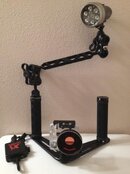Sorry to the OP for going a little OT but my earlier posts were more general mode use in relation to the thread title then any specific user, just passing on some info I have learned from many dives with GoPro cameras. Some will agree some wont, there are no rules set in stone in my eyes and I regularly try different approaches to things to see if I can get a better result. Im far from using all the traditional rules of underwater video even though I understand most of them but theory doesnt always turn out as you expect in practice. There are times you just need to take a dive or 2 and play around with all the settings then figure out what works best for you when. I am posting what has worked for me and having access to a few GoPro cameras I have done lots of side by side video tests in all the modes so I have a reasonable idea of what works and what doesn't for me.
If your struggling you may want to follow my advice or better still if you have the time go out and try all modes, its a bit tricky as you have a trip coming up. The first thing I did with my first gopro before my first away trip was to do a few test dives trying out all the options hoping to have things sorted so I dont waste any dives fiddling with the camera.
Marty, I agree with you. This was edited in FCP X and I was mostly playing around learning the tool and was not all that impressed with the stabilization either, the old Motion did a heck of a lot better IMO. I'm switching to Media Composer 6 now and find the tracking to be extremely good I'll see how it does.
The shots where the stabilization is most evident had less to do with the conditions and more to do with the shot itself. For the tiny scorpion fish I had to hold the tray away from my body and by a single handle basically shooting blind as I could not see the monitor. And the first lobster was tight corners again extending my arms. I'm never pleased with any of my underwater footage because I know how much it's lacking yet people who have never been underwater marvel at it.
One thing I'm tinkering with is adding a little more weight to my SRP tray and I wonder how much weight your SOLAs add to the equation and if you feel like it makes the rig top heavy? I don't even know why I ask that since in all reality, if I'm going to invest into some SOLA lights I'd probably go with a DSLR and forgo shooting the GoPro altogether.
Thanks for your input!
I am not saying you have terrible footage but I just haven't seen many good examples of software motion stabilization of underwater video. I think the GoPro is a great little camera allowing more people to get into underwater video which before was much more expensive to get into. Im always the harshest critic of my own videos even though some others seem to not see as many flaws as I do at times lol.
The best examples I have seen of this software stabilization is on land walking a basic direction and the software here can do a job almost to steady cam level at times, it will use the horizon and consistent shapes of a path or road to aid its orientation, underwater there just arent as many good reference points for it to use. If you pan the camera at all it will struggle, underwater with no horizon or other such consistant reference points it will always be a battle. Best results probably using short clips with no camera panning involved may work best underwater but my basic tests turned out not much better then your example so I just try focus on improving my diving technique and a steady hand.
With the SRP tray, the gopro doesn't have much air in the housing so its negative in the water, the tray is very light too but adds to the negative buoyancy. For best stabilization your best to try and get the full setup just slighty negative but very close to neutral. This pretty much helps it float in the water and you just need to guide it along. I have used this at times with just a couple of padded foam tubes around the handles or tray frame and worked well. Here is an earlier version I tried along with a third handle for single handed use showing it in action, I did find I didnt use the third handle much anyway so traditional 2 handle setup is still best and you can see the foam here on the tray base, it works pretty much the same on the handles.
[video=youtube;DG9KrASLX6w]http://www.youtube.com/watch?v=DG9KrASLX6w[/video]
Having more cameras and lights will add to the weight but doesn't make it much easier to keep still, it may take away some micro movements but overall wont help you out too much with a very negative setup, its still not too heavy and I have used 4 cams and lights with no floats many times with decent results but not as good as those where I balance the setup better in the water. Even with a tray though you need practice and using it stretched out one handed in a strong current or surge will never give the best results.




